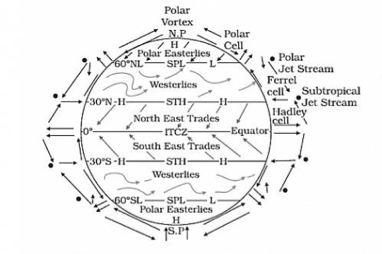19 Dec 2023 : Daily Answer Writing
Mains Answer Writing
19-December-2023
Q1) With help of a neat diagram, describe the general atmospheric circulation. Highlight the factors that affect the movement of winds on earth?
ANSWER
- The general atmospheric circulation refers to the large-scale movement of air in the Earth’s atmosphere. It is driven by differences in temperature and pressure between different regions of the Earth’s surface, which in turn are caused by uneven heating of the planet by the sun.The general atmospheric circulation can be divided into three major cells in each hemisphere:
- Hadley cell: The Hadley cell is located near the equator. It begins with warm, moist air rising at the equator, which moves towards the poles and cools, sinking back down to the surface at around 30 degrees north and south of the equator. This sinking air creates high-pressure zones known as the subtropical highs, which are associated with dry, clear weather.
- Ferrel Cell: The Ferrel cell is in the mid-latitudes. It is driven by the interaction between the Hadley and Polar cells and lies in between these two cells. Air moves poleward and eastward at the surface, rises, and moves equatorward in the upper atmosphere, and then sinks again over the mid-latitudes.
- Polar Cell: The Polar cell is located near the poles. It begins with cold, dense air sinking at the poles and moving towards the mid-latitudes, where it is warmed and rises, creating low-pressure zones. This rising air then moves towards the poles in the upper atmosphere, where it cools and sinks again, completing the cycle.
Fig: The global atmospheric circulation
The movement of winds on Earth is affected by the following factors:
- Pressure Gradient: The difference in air pressure between two points in the atmosphere creates a pressure gradient force that drives the movement of air from high-pressure areas to low pressure areas.
- Coriolis Effect: The rotation of the Earth causes the Coriolis effect, which deflects moving air to the right in the Northern Hemisphere and to the left in the Southern Hemisphere. This effect becomes stronger at higher latitudes and has a significant influence on the direction of largescale wind patterns.
- Friction: The frictional force of the Earth’s surface can slow down and alter the direction of wind flow. This effect is most pronounced near the surface, where friction with the ground and vegetation can create obstacles to the smooth flow of air.
- Land and Sea Breezes: Temperature differences between land and water can create local wind patterns, with warm air over land rising and cooler air over water moving in to replace it, creating a sea breeze. At night, the reverse occurs, with cooler air over land moving towards the warmer water, creating a land breeze.
- Topography: The shape and elevation of the Earth’s surface can affect wind flow. It creates regions of high and low pressure, and funnels air masses through valleys and mountain ranges.
- Monsoons: Monsoons are large-scale seasonal wind patterns that are driven by differences in temperature and pressure between land and sea. These winds can bring heavy rain and flooding to some regions of the world, particularly in Asia.
The movement of winds on Earth is a complex phenomenon. The general atmospheric circulation is an important model in understanding the global weather patterns and climate and the distribution of heat and moisture around the planet.
Upload Answer here
For Enquiry

20 Dec 2023 : Indian Express

20 December 2023 : The Hindu Editorial Notes PDF

20 Dec 2023 : Daily Current Affairs

20 Dec 2023 : PIB

UNICEF Full Form: United Nations’ Child Protection Arm

IMF Full Form Explained: A Global Financial Institution

CRZ full Form and What it is? Complete detail about CRZ

19 Dec 2023 : Daily Quiz

Full Form of BRICS, History and it’s Importance for India

15th Finance Commission Recommendations Notes for UPSC

